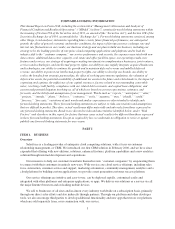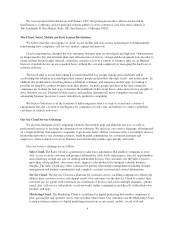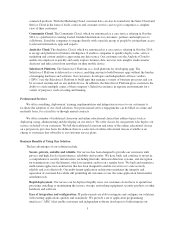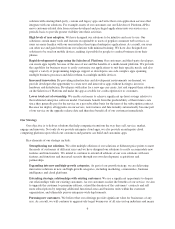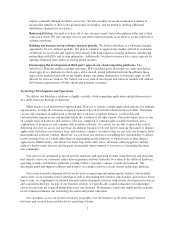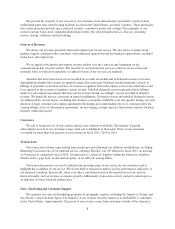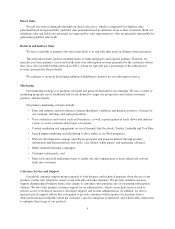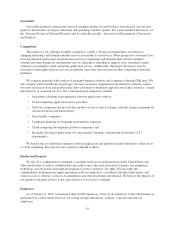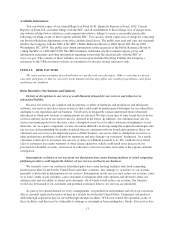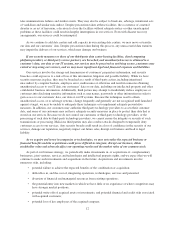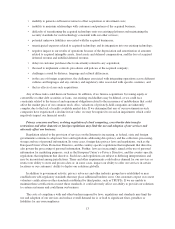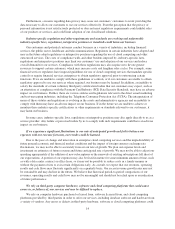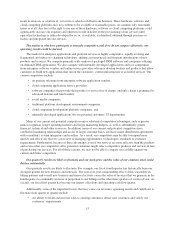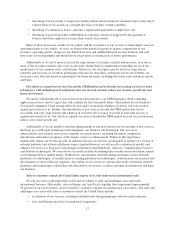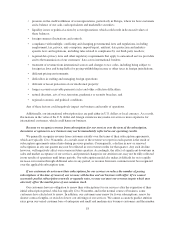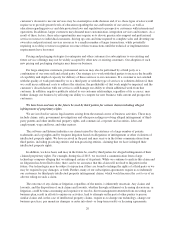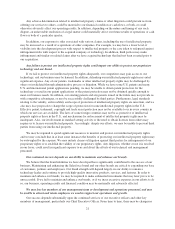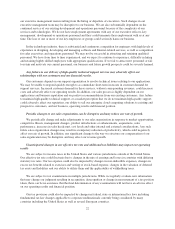Salesforce.com 2015 Annual Report Download - page 19
Download and view the complete annual report
Please find page 19 of the 2015 Salesforce.com annual report below. You can navigate through the pages in the report by either clicking on the pages listed below, or by using the keyword search tool below to find specific information within the annual report.• inability to generate sufficient revenue to offset acquisition or investment costs;
• inability to maintain relationships with customers and partners of the acquired business;
• difficulty of transitioning the acquired technology onto our existing platforms and maintaining the
security standards for such technology consistent with our other services;
• potential unknown liabilities associated with the acquired businesses;
• unanticipated expenses related to acquired technology and its integration into our existing technology;
• negative impact to our results of operations because of the depreciation and amortization of amounts
related to acquired intangible assets, fixed assets and deferred compensation, and the loss of acquired
deferred revenue and unbilled deferred revenue;
• delays in customer purchases due to uncertainty related to any acquisition;
• the need to implement controls, procedures and policies at the acquired company;
• challenges caused by distance, language and cultural differences;
• in the case of foreign acquisitions, the challenges associated with integrating operations across different
cultures and languages and any currency and regulatory risks associated with specific countries; and
• the tax effects of any such acquisitions.
Any of these risks could harm our business. In addition, if we finance acquisitions by issuing equity or
convertible or other debt securities or loans, our existing stockholders may be diluted, or we could face
constraints related to the terms of and repayment obligation related to the incurrence of indebtedness that could
affect the market price of our common stock. Also, valuations of privately-held companies are inherently
complex due to the lack of readily available market data. If we determine that any of our investments in such
companies have experienced a decline in fair value, we may be required to record an impairment, which could
negatively impact our financial results.
Privacy concerns and laws, evolving regulation of cloud computing, cross-border data transfer
restrictions and other domestic or foreign regulations may limit the use and adoption of our services and
adversely affect our business.
Regulation related to the provision of services on the Internet is increasing, as federal, state and foreign
governments continue to adopt new laws and regulations addressing data privacy and the collection, processing,
storage and use of personal information. In some cases, foreign data privacy laws and regulations, such as the
European Union’s Data Protection Directive, and the country-specific regulations that implement that directive,
also govern the processing of personal information. Further, laws are increasingly aimed at the use of personal
information for marketing purposes, such as the European Union’s e-Privacy Directive, and the country-specific
regulations that implement that directive. Such laws and regulations are subject to differing interpretations and
may be inconsistent among jurisdictions. These and other requirements could reduce demand for our services or
restrict our ability to store and process data or, in some cases, impact our ability to offer our services in certain
locations or our customers’ ability to deploy our solutions globally.
In addition to government activity, privacy advocacy and other industry groups have established or may
establish new self-regulatory standards that may place additional burdens on us. Our customers expect us to meet
voluntary certification or other standards established by third parties, such as TRUSTe. If we are unable to
maintain these certifications or meet these standards, it could adversely affect our ability to provide our solutions
to certain customers and could harm our business.
The costs of compliance with and other burdens imposed by laws, regulations and standards may limit the
use and adoption of our services and reduce overall demand for it, or lead to significant fines, penalties or
liabilities for any noncompliance.
13


